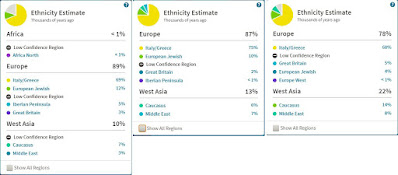 |
| Download your DNA to use elsewhere. |
You can submit that raw DNA file to other websites for a different analysis. For example, after attending a genealogy seminar featuring Judy Russell, the Legal Genealogist, I paid a small fee to submit my raw DNA to FamilyTreeDNA.com. She suggested that if you submit your DNA to multiple sites, you're more likely to find relatives.
My FamilyTreeDNA analysis was similar to what AncestryDNA told me. The percentages were different, but it wasn't far off. I like AncestryDNA better because it pinpoints my origins as "Southern Italian" and not just "Southeast Europe".
 |
| This section tells me my parents are related! |
I looked for more sites to analyze my DNA and found that I could create a free account on Gedmatch.com. Look for "Raw DNA file Uploads" in the "File Uploads" section of the page. Follow the steps to submit the ZIP file of your raw DNA to Gedmatch.
You'll get a "kit number" once your DNA is analyzed. Keep that number handy. Now you're ready to try out a handful of tests. Look in the "DNA raw data" column of the "Analyze Your Data" section of the main page.
Today let's focus on "Are your parents related?" Click that test name and enter your kit number. On the results page, you'll see each of your chromosomes. Color-coding shows how many segments they have in common. Scroll down to the bottom of the page for a conclusion.
My test says, "This analysis indicates that your parents are probably distantly related." Up at the top of the page, my Chromosome 2 shows my largest DNA match, measuring 7.6 Centimorgans.
I decided to run a quick test to help verify these results. I know that my father's parents were third cousins. So his raw DNA should also show that his parents were related, but my mom's DNA should not show a relationship between her parents.
Gedmatch passed my test. It did show that my dad's parents were related, but my mom's were not. My dad's DNA has two chromosomes with a significant match. The results also showed that his parents were more closely related than my parents.
My test gives me good confidence in this parent-relationship test overall.
 |
| That face you make when your dad is in your mom's DNA match list. |
Once I learned my mom and dad are related, I went back to AncestryDNA to see if dad shows up in mom's DNA match list, and mom shows up in dad's.
They do!
My mom's DNA match list has my dad as her 4th cousin. More specifically, the results point to high confidence that they are 4th–6th cousins. A standard cousin chart tells me that if they're 4th–6th cousins, they share a set of 3rd–5th grandparents.
 |
| Cousin Chart, showing how two people are related. |
My own ancestor chart (see How to Visualize Your Ancestor-Finding Progress) shows me how many of my parents' 3rd–5th grandparents (my 4th–6th grandparents) I've identified. So far, I have not found my parents' common ancestors.
My ancestors all came from a few neighboring towns in rural Italy. I visited those towns. My one grandfather's town is so close to my other grandfather's town that I could see one town from the other.
I think at some point, a man from one of their towns married a woman from the other.
Thanks to this free, secondary analysis of my DNA, I have a purpose. I must find out exactly how my parents are related!
What secrets are locked in your DNA?









